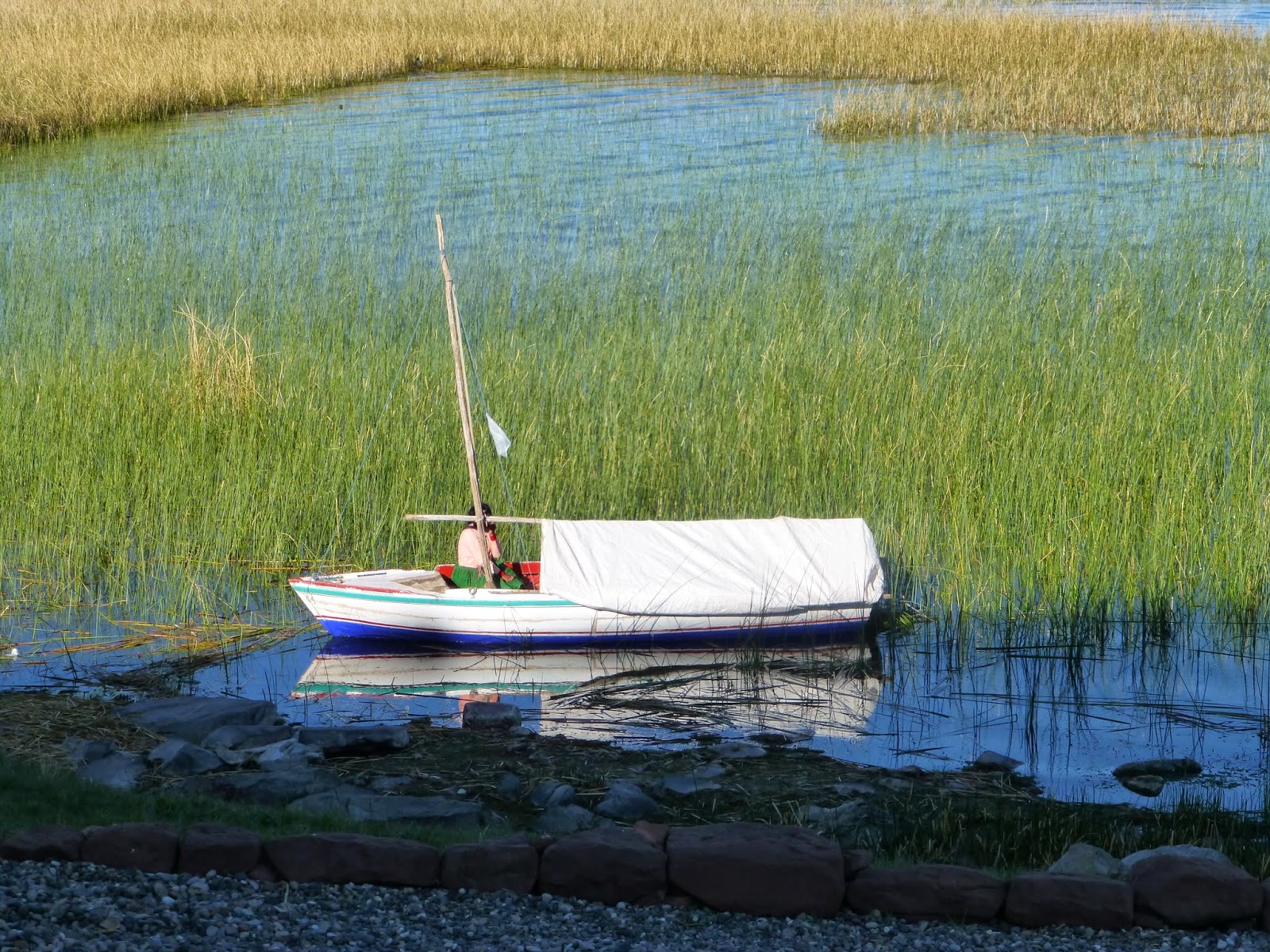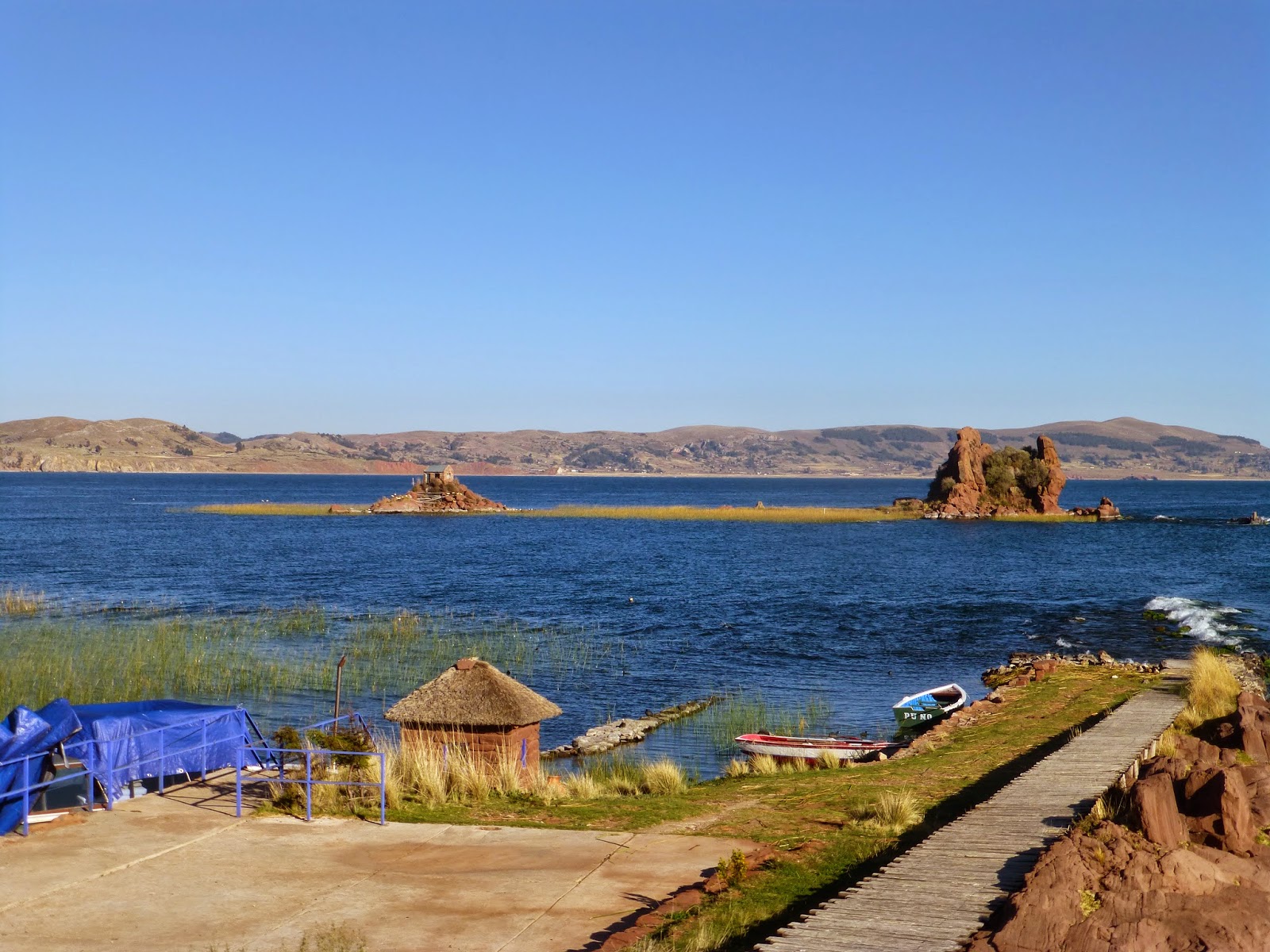We traveled by the Andean Explorer train from Cusco to Puno, a journey of roughly eight hours. The scenery was great, with panoramic vistas of the Huatanay River and, later, the vast Andean plains. Isolated farms would occasionally dot the landscape and farmers in colorful attire tended herds of alpacas, llamas, or sheep.
A stop along the way at a small settlement with a market
Views along the way
Puno appears to be a rough-and-tumble town on the banks of Lake Titicaca. When we asked the guide what the major industry was, he noted the proximity to Bolivia and replied, "smuggling." We spent little time in Puno, as our lodge, Titilaka, was several miles distant but well worth the trip. It is an absolutely stunning, contemporary property, constructed on the waterfront and featuring floor-to-ceiling glass windows that afford spectacular views of the immense lake. At 120 miles long and 50 miles wide, Titicaca sprawls over more than 3,000 square miles and is reputedly the highest body of navigable water in the world--over 13,000 lung-challenging feet.
View from the resort
Outdoor deck
Interior shots of the comfortable property
We boated to the Isla Taquile, a World Heritage site where 350 families maintain their traditional lifestyle. The island is fascinating for several reasons, including its unique heritage. When Taquile and a neighboring island were acquired by a Spanish nobleman centuries ago, he wanted to create an island in his own image. Accordingly, he banned llamas, so that the islanders were forced to be more servile and had to carry everything themselves. Note that carrying anything on Taquile is no easy task, as the village is situated more than 540 very steep steps from the small pier. The nobleman, although 'noble' scarcely seems apt, also had the islanders wear clothes which reminded him of his region in Spain. To this day, they continue to wear the attire.
A new walkway was placed last year and covers roughly half the distance uphill from the pier
Our walk along the cliff
Taquile also has an amazing tradition of knitting. Men learn to knit, and how to make their wives clothing, and vice-versa. For a man to request a woman's hand in marriage, he must knit and present her father with a cap woven so tightly that it will retain water for a time. Married men wear red knitted caps while bachelors wear red and white. Single women sport multi-colored pompoms on their skirts while married woman wear red ones. There is a hierarchy of elected community leaders, readily identified by the style or coloring of their hats, belts, or other attire.
One of the locals guided us along a ridge overlooking the lake and the Cordillera Real mountains. He knitted the entire time we jostled along the winding, stony path and never appeared out of breath despite the altitude. Although the coca leaves seemed to help, we needed to pause occasionally to rest. Interestingly, another guide noted that people accustomed to higher altitudes often do not handle lower altitudes well--in her case, she feels slightly ill and her extremities swell.
Our guide, constantly knitting
We also visited the Islas Uros, or floating islands. Although many travelers complain that the islands have become floating souvenir stands, we nevertheless found the visit interesting and informative. Centuries ago, the Uros people developed and occupied the islands as a way of escaping mainland hostilities. Constructed from the totora reed, the islands float and house from 2-10 families.
Because the reeds rot, the islands must be constantly replenished. This often involves submersion in the cold water, but the Uros people claim that they have 'black blood' and can withstand low temperatures. Walking on an island is a unique experience and what I imagine it would be like to stroll on a massive sponge. We also rode on a traditional raft constructed of the totora reed, although it is common today for floatation to be assisted by modern products, such as empty plastic bottles. Disputes between families are typically resolved amicably but, in extreme cases, a large saw may be used to cut loose a recalcitrant family.
Typical reed boat
Explaining how a floating island is constructed
Typical residential structures
Traditional cooking vessels
Watchtowers are used to communicate with other floating islands
Bird island--most islands erect a structure of reeds to symbolize the island
Our final attraction in the Puno region was a visit to the Sullustani Burial Towers, on the shores of the picturesque Laguna Umayo. Some of the burial towers approach 40 feet in height and were originally erected by a pre-Incan people known as the Collas. When the Incas conquered the Collas, they maintained the site and used it to bury their own dead nobility. The mysterious towers, perched above the stunning lake, are haunting.
Note the amazingly tight stonework
Stunning views in every direction
From the cliffs of Lima, the tapir in the rainforest, the intricate stonework of Machu Picchu, the vast beauty of Titicaca, the solemnity of Sullustani--a wonderful country and people, and a spectacular trip.













































No comments:
Post a Comment